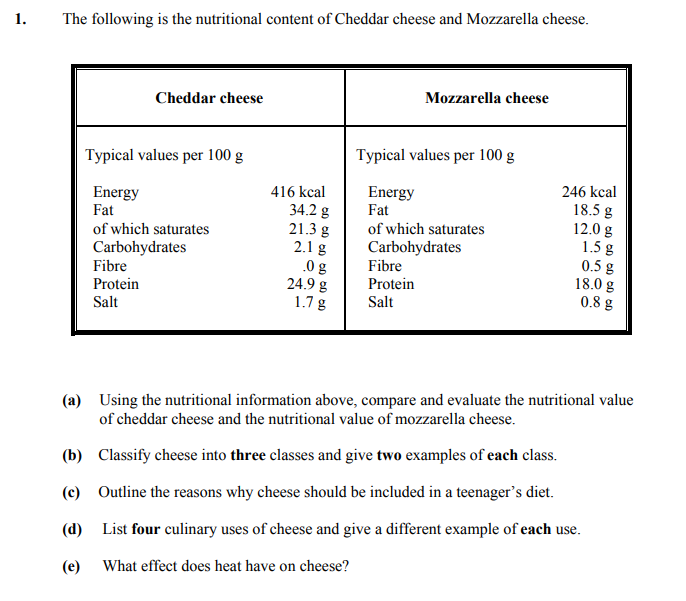Photo AI
The following is the nutritional content of Cheddar cheese and Mozzarella cheese - Junior Cycle Home Economics - Question 1 - 2016
Question 1

The following is the nutritional content of Cheddar cheese and Mozzarella cheese. Cheddar cheese Typical values per 100 g Energy 416 kcal Fat 34.2 g of which satura... show full transcript
Worked Solution & Example Answer:The following is the nutritional content of Cheddar cheese and Mozzarella cheese - Junior Cycle Home Economics - Question 1 - 2016
Step 1
Using the nutritional information above, compare and evaluate the nutritional value of cheddar cheese and the nutritional value of mozzarella cheese.
Answer
When comparing Cheddar and Mozzarella cheese based on the provided nutritional content, several differences emerge.
Energy Content
Cheddar cheese is significantly higher in energy, providing 416 kcal per 100 g, compared to Mozzarella's 246 kcal. This makes Cheddar a denser energy source, suitable for those needing higher caloric intake.
Fat Content
Cheddar contains 34.2 g of fat, whereas Mozzarella has only 18.5 g. The saturated fat levels are also different, with Cheddar at 21.3 g compared to Mozzarella's 12.0 g. High saturated fat intake is associated with health risks, making Mozzarella a potentially healthier choice.
Carbohydrates and Fibre
Mozzarella is higher in carbohydrates (15.5 g) and has some dietary fibre (0.5 g), which may support digestive health. Cheddar, on the other hand, has negligible carbohydrates and no fibre content.
Protein Content
Both cheeses are good sources of protein; however, Cheddar has 24.9 g, compared to Mozzarella's 18.0 g. Thus, Cheddar provides more protein per serving.
Salt Content
Cheddar cheese also contains more salt (1.7 g) compared to Mozzarella (0.8 g). High salt intake can contribute to hypertension and other health problems, which may be a consideration for consumers.
Conclusion
In summary, while Cheddar cheese is a richer source of energy and protein, it also carries higher fat and salt content. Mozzarella may be a better option for those monitoring their fat and salt intake while still providing beneficial nutrients.
Step 2
Classify cheese into three classes and give two examples of each class.
Answer
Cheese can be classified into the following three classes:
1. Hard Cheese
- Examples: Cheddar, Parmesan
- These cheeses have a low moisture content and are aged for a longer time, making them suitable for grating and adding flavor to dishes.
2. Semi-Hard Cheese
- Examples: Gouda, Edam
- These cheeses have a slightly softer texture and are often used in sandwiches and melts due to their versatility.
3. Soft Cheese
- Examples: Brie, Cream Cheese
- Soft cheeses are known for their creamy texture and are typically spreadable, ideal for dips and desserts.
Step 3
Outline the reasons why cheese should be included in a teenager's diet.
Answer
Including cheese in a teenager's diet is beneficial for several reasons:
1. Nutritional Value
Cheese is rich in essential nutrients, including calcium and protein, which are crucial for growth and development during the teenage years.
2. Bone Health
High in calcium, cheese aids in the development of strong bones and teeth, which is especially important for teenagers experiencing rapid growth.
3. Energy Source
Cheese provides a concentrated source of energy, which is pertinent for active teenagers, helping to fuel their daily activities and sports.
4. Versatility
Cheese can be incorporated into various meals and snacks, making it an easy and convenient option for busy teenagers, while also enhancing flavor.
Step 4
List four culinary uses of cheese and give a different example of each use.
Answer
Cheese has numerous culinary uses, including:
1. Savory Dishes
- Example: Pizza with mozzarella
- Cheese provides flavor and texture to savory dishes.
2. Desserts
- Example: Cheesecake
- Cheese can also be a vital component in sweet dishes, adding richness.
3. As a Garnish
- Example: Grated Parmesan on pasta
- It is often used to enhance the visual appeal and flavor of dishes.
4. Snacks
- Example: Cheese slices on crackers
- Cheese is a convenient and nutritious option for on-the-go snacking.
Step 5
What effect does heat have on cheese?
Answer
Heating cheese causes a range of changes:
1. Texture Changes
- Protein coagulation occurs when cheese is heated, leading to a firmer texture.
2. Flavor Changes
- Heat can enhance and modify the flavors of cheese, sometimes leading to a more intense taste.
3. Overcooking Effects
- Overheating can cause cheese to become tough and difficult to digest, as well as altering its original flavor profile.
